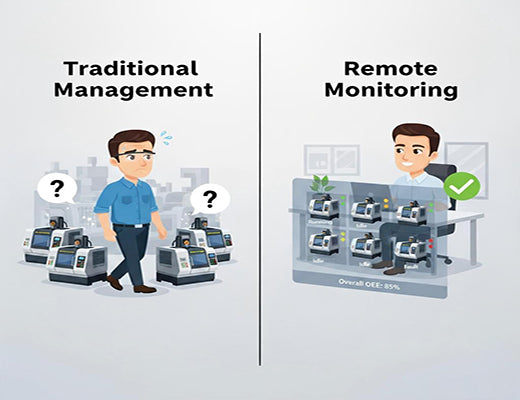
A Guide to Remote Monitoring for Your CNC Router Fleet
|
|
Time to read 4 min
|
|
Time to read 4 min
This guide explains how remote CNC monitoring transforms the management of your CNC router fleet. By connecting each machine via an edge gateway and centralizing the data onto a cloud platform, you move from managing individual "black boxes" to overseeing a fully transparent, data-driven operation. We'll cover the architecture, the key performance indicators (KPIs) you can track, and how this real-time visibility is crucial for boosting OEE, minimizing downtime, and optimizing your entire machining process.
Remote monitoring provides a centralized, real-time view of the status, performance, and health of every CNC router in your fleet, regardless of location.
It replaces manual data collection and guesswork with automated, accurate insights displayed on a CNC machine dashboard.
Key benefits include instant downtime alerts, automated OEE calculation, optimized maintenance scheduling, and improved overall shop floor transparency.
A complete solution requires an edge gateway at each machine, a secure network connection, and a central cloud platform (like RCMS combined with a SCADA/MES or BI tool).
You walk through your machine shop. One CNC router is actively cutting, another sits idle waiting for material, and a third has an ominous red alarm light flashing. To understand the why behind each machine's status, you have to physically go to each one, talk to the operator, or sift through yesterday's paper logs. Now, imagine managing three factories like this. It's inefficient, slow, and based on gut feelings rather than hard data.
What if you could see the real-time status, performance, and health of every single CNC router you own, anywhere in the world, on a single screen on your desk?
Let's be clear: you can. This is the power of remote CNC monitoring. It's about transforming your fleet from a collection of isolated assets into a single, transparent, and intelligently managed system.

Building a scalable remote monitoring system involves three key layers:
The 'aha!' moment for any production manager is when they see the actionable insights that real-time data provides. Your CNC machine dashboard can now track critical KPIs, such as:

Remote CNC monitoring is the foundational technology for any modern machine shop aiming for operational excellence. It replaces reactive firefighting and manual data collection with proactive, data-driven management. By providing a single source of truth for your entire CNC router fleet, it empowers you to make faster decisions, reduce waste, minimize downtime, and ultimately, run a more profitable and competitive operation.
Further Reading:
Why Connect Your CNC Router to the Network? The Business Case for IIoTWhat Data Can You Get From Your CNC Router? A Guide to Key MetricsThe Role of an Edge Gateway in CNC Router Data Acquisition
A1: You have many options. Data from the edge gateway (typically sent via MQTT or OPC UA) can be fed into traditional SCADA systems, MES software, dedicated IIoT platforms (like AWS IoT or Azure IoT), or Business Intelligence ( BI) tools (like Grafana or Power BI). The choice depends on your existing infrastructure and specific visualization needs.
A2: By accurately tracking machine run hours, spindle hours, and specific alarm occurrences, you can move from calendar-based preventive maintenance to condition-based or usage-based maintenance. This ensures that maintenance is performed when it's actually needed, reducing unnecessary servicing while preventing unexpected failures.
A3: This is a critical function often overlooked. A dedicated device management platform like Robustel's RCMS is essential. It allows you to monitor the health, connectivity status, and data usage of all your edge gateways, perform remote configuration changes, and deploy security updates across your entire fleet.